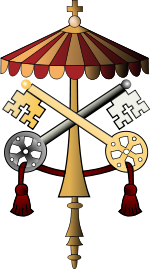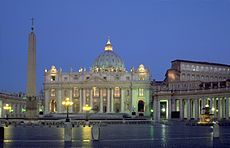- Papal conclave, October 1978
-
Papal conclave, October 1978 
Dates October 14–October 16, 1978 Location Sistine Chapel, Apostolic Palace, Vatican City Dean Carlo Confalonieri Vice Dean Paolo Marella Camerlengo Jean-Marie Villot Protodeacon Pericle Felici Ballots Pope elected after 8 ballots Elected Pope Karol Wojtyła
(took name John Paul II)The Papal conclave of October 1978 was triggered by the sudden death, after only thirty-three days in office, of Pope John Paul I on September 28. When the cardinals elected John Paul I on August 26, they expected he would reign for at least a decade. Instead they found themselves having to elect his successor within six weeks. The conclave to elect John Paul I's successor began on October 14, and ended two days later, on October 16, after eight ballots. The cardinals elected Cardinal Karol Wojtyła, then Archbishop of Kraków, as the new pope. Resulting in the most recent Year of Three Popes, he accepted his election and took the pontifical name of John Paul II.
Contents
Papabili and proceedings
 John Paul II
John Paul II
Ten days after the funeral of Pope John Paul I, on October 14, the doors of the Sistine Chapel were sealed and the conclave commenced. It was divided between two particularly strong candidates for the papacy: Giuseppe Siri, the conservative Archbishop of Genoa, and the liberal Giovanni Benelli, the Archbishop of Florence and a close associate of John Paul I.
Supporters of Benelli were confident that he would be elected. In early ballots, Benelli came within nine votes. But the scale of opposition to both papabili meant that neither was likely to receive the two-thirds plus one needed for election. Cardinal Franz König, the influential and widely-respected Archbishop of Vienna, individually suggested to his fellow electors a compromise candidate: the Polish Cardinal Karol Józef Wojtyła, whom König knew and by whom he was highly impressed.
Also among those cardinals who rallied behind Wojtyła were supporters of Siri, Stefan Wyszyński, most of the American cardinals (led by John Krol), and other moderate cardinals. Wojtyła ultimately defeated Benelli (who was actually the supposed candidate Wojtyła himself had voted for) on the eighth ballot on the third day with, according to the Italian press, 99 votes from the 111 participating electors. He accepted his election with these words: "With obedience in faith to Christ, my Lord, and with trust in the Mother of Christ and the Church, in spite of great difficulties, I accept." The Pole, in tribute to his immediate predecessor, then took the regnal name of John Paul II. He became the first non-Italian pope since the Dutch Adrian VI, who reigned from 1522 to 1523.
PAPAL CONCLAVE, October 1978 ELECTORS 111 Present 111 Africa 12 Latin America 19 North America 12 Asia 9 Italians 25 Rest of Europe 30 Oceania 4 Mid-East 0 At 6:18 p.m., the white smoke rose from the chimney of the Sistine Chapel, meaning that a new pope had been elected. As the senior Cardinal Deacon, a visibly excited Pericle Felici gave the traditional Latin announcement for Wojtyła's election on the balcony of St. Peter's Basilica. "Annuntio vobis gaudium magnum: Habemus papam! Eminentissimum ac reverendissimum dominum, dominum Carolum, sanctæ romanæ Ecclesiæ cardinalem, Wojtyła, qui sibi nomen imposuit Ioannis Pauli."
When Felici pronounced the new pope's forename, some members of the crowd below thought that the aged Dean of the College of Cardinals, Carlo Confalonieri (a non-participant in the conclave because he was over the age limit), had been elected; upon hearing his surname, some also thought he was an African or even a Japanese.[citation needed] More confusion ensued when it was thought that the new pope was Ugo Poletti, the vicar for Rome, after an Italian newsreporter announced, Polacco ("Polish").[citation needed] John Paul II appeared on the balcony at 7:15, and while gripping the balustrade, broke precedent by delivering a brief speech before his first Urbi et Orbi blessing:
Praised be Jesus Christ! Dear brothers and sisters, we are still all very saddened by the death of the very dear Pope John Paul I. And now the most eminent cardinals have called a new bishop of Rome. They called him from a far-away country...far, but always near in the communion of faith and the Christian tradition. I was afraid in receiving this nomination, but I did it in the spirit of obedience to Our Lord and with total trust in his Mother, the Most Holy Madonna. I don't know if I can express myself well in your – in our – Italian language. But if I make a mistake, you will correct me. And so I introduce myself to you all, to confess our common faith, our hope, our trust in the Mother of Christ and of the Church, and also to begin again on this path of history and of the Church with the help of God and with that of men.[1]NCR Senior Correspondent John Allen has stated that during the speech, a member of the Roman Curia requested that the new pope end his speech. However, the pope ignored the admonition and continued talking. The speech, however, made a good impression on Italian listeners who were nervous at the prospect of a foreign pope.[2] This was due also to an intentional mistake made by the newly elected Pope during this speech, given in Italian language, a mistake that won immediately the applause of the crowd, releasing the tension of the event. John Paul II said (in Italian): "...se mi sbaglio mi corigerete!" (something like: "if I make a mistake, you will corict me!" The correct form would be: "mi correggerete.").[3]
This was also the last conclave of the 20th century, as the next election for a pope did not occur until after the death of John Paul II in 2005.
Cardinals over 80 in 1978 Papal conclaves
Part of a series on the Catholic Church 
Organisation Pope – Pope Benedict XVI College of Cardinals – Holy See Ecumenical Councils Episcopal polity · Latin Church Eastern Catholic Churches Background History · Christianity Catholicism · Apostolic Succession Four Marks of the Church Ten Commandments Crucifixion & Resurrection of Jesus Ascension · Assumption of Mary Theology Trinity (Father, Son, Holy Spirit) Theology · Apologetics Divine Grace · Sacraments Purgatory · Salvation Original sin · Saints · Dogma Virgin Mary · Mariology Immaculate Conception of Mary Liturgy and Worship Roman Catholic Liturgy Eucharist · Liturgy of the Hours Liturgical Year · Biblical Canon Rites Roman · Armenian · Alexandrian Byzantine · Antiochian · West Syrian · East Syrian Controversies Science · Evolution · Criticism Sex & gender · Homosexuality Catholicism topics Monasticism · Women · Ecumenism Prayer · Music · Art Catholicism portal
This is a list of Roman Catholic cardinals over the age of 80 as of the death of Pope Paul VI on August 6, 1978. As such, they were ineligible to vote in the Papal conclave beginning August 25 to elect Paul's successor, according to the motu proprio Ingravescentem aetatem, of November 21, 1970 and the apostolic constitution Romano Pontifici Eligendo of October 1, 1975.
Because Pope John Paul I died after only thirty-three days in office without creating any cardinals, and none of the cardinals who were eligible to vote turned eighty between John Paul I's election and the beginning of the second conclave on October 14 that elected Pope John Paul II, the lists of over-age cardinals for the two 1978 conclaves are identical.
The cardinals ineligible to participate in the two 1978 conclaves because they were at least eighty years old are listed below, arranged by date of promotion to the cardinalate.
Cardinals elevated by Pope Pius XII
- February 18, 1946
- Carlos Carmelo Vasconcellos Motta, archbishop of Aparecida
- Josef Frings, former archbishop of Cologne
- Antonio Caggiano, former archbishop of Buenos Aires
- January 12, 1953
- James Francis McIntyre, former archbishop of Los Angeles
- Alfredo Ottaviani, prefect emeritus of the S.C. for the Doctrine of the Faith
Cardinals elevated by Pope John XXIII
- December 15, 1958
- Carlo Confalonieri, bishop of Ostia and Palestrina, archpriest of the Liberian basilica, and Dean of the Sacred College of Cardinals
- Antonio María Barbieri, O.F.M., Cap. former archbishop of Montevideo
- Alberto di Jorio
- December 14, 1959
- Paolo Marella, bishop of the title of the suburbicarian see of Porto e Santa Rufina, archpriest of the Vatican basilica, sub-dean of the Sacred College of Cardinals
Cardinals elevated by Pope Paul VI
- February 22, 1965
- Jozef Slipyj, archbishop major of Lviv of the Ukraines (note that many historians believe Slipyj was elevated in pectore in the consistory of March 28, 1960 but that creation would have expired when John XXIII died in 1963)
- Lawrence Joseph Shehan, former archbishop of Baltimore
- June 26, 1967
- Patrick Aloysius O'Boyle, former archbishop of Washington
- Pietro Parente
- April 28, 1969
- Miguel Darío Miranda y Gómez, former archbishop of Mexico City
- March 5, 1973
- Ferdinando Giuseppe Antonelli, O.F.M
See also
References
- Notes
- ^ Catholic-Pages. Pope John Paul II April 2, 2005
- ^ TIME Magazine. A "Foreign" Pope October 30, 1978
- ^ The first speech of John Paul II on Youtube
External links
- Politics and the Polish Pope from The New Republic, October 28, 1978. The author discusses the election of Cardinal Wojtyła, and its ramifications for communism. (Subscription required.)
- A "Foreign" Pope from Time Magazine, October 30, 1978. No subscription required.
Holy See elections Pre-1059 Before 105911th century 12th century 13th century 14th century 15th century 16th century 17th century 18th century 19th century 20th century 21st century Categories:- 1978 elections
- 1978 elections in Europe
- Papal conclaves
- Pope John Paul II
- 20th-century Roman Catholicism
- 1978 in religion
- February 18, 1946
Wikimedia Foundation. 2010.
